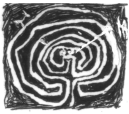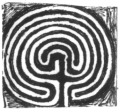Jill Purce in her book,
"The Mystic spiral" described the Cretan coin with the circular maze as being
"from Knossos, home of the 'original' labyrinth". But was Crete the home of the
original labrinth? If so, it is unexpected to find the same pattern, or at least a
knowledge of its construction, in the Stone Age amid primitive surroundings in the Alps
one or two thousand years earlier than its adoption as the royal insignia of Crete.
Fig. 55: Basic Mazes from Val
Camonica


The maze with the "monster" which we
have been admiring has what looks like a bird on the left and a figure with a curved
stick, maybe a bow, on the right. This Jill Purce sees as "the warrior or initiate...
fighting the oculiform face at the centre of the labyrinth; the moment of death at the
centre is followed by rebirth." The oculiform face is echoed in another image from
Val Camonica, and further related is the image of a struggle in which a giant serpent has
a human figure caught around the waist. These are evidently very primitive designs,
indeed, so a problem of dating arises when a recognizably 'Cretan' labyrinth occurs
alongside.
According to Janet Bord, in her book,
Mazes and Labyrinths of the World, " An important group of rock carvings has been
discovered in the Camonica Valley in the Italian Alps north-east of Milan. The oldest
carvings date form the Neolithic period, and the changes in style show that carving was
continued up to the Roman Conquest.
Labyrinth designs occur frequently. Some
incorporate figures or faces at the centre, or just two dots to represent eyes - perhaps
showing a monster as an integral part of the labyrinth. Later designs show Greek
influence, and the Cretan-style labyrinth shown here is dated to around 300 BCE. The
others are roughly dated to the third or second millennium BCE.
![]()